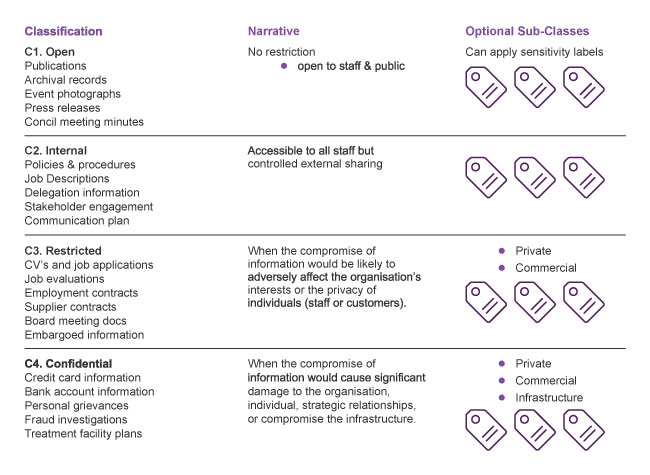Small to medium-sized businesses (SMBS) often struggle with compliance requirements that larger enterprises handle with dedicated teams and sophisticated systems, from GDPR to the new Privacy Act and industry-specific requirements (e.g. HIPAA, APRA, etc). However, proper document control isn't just a luxury for big companies; it is essential for businesses of any size to maintain operational integrity and avoid unwanted outcomes.
This is particularly critical for SMBs operating with limited resources, as compliance failures can be disproportionately damaging to their bottom line. Depending on the violation, the financial impact can range from thousands to millions of dollars and may lead to lawsuits and Director liability. Compliance failures can also cause operational disruption, and in an era where transparency is vital for businesses, it can erode customer trust and partner relationships and lead to unwanted audit rigours.
Understanding document control challenges for SMBs
Document control is critical for managing compliance by ensuring that documents are accurate, consistent, and current. However, these everyday challenges make compliance difficult for many SMBs:
- Decentralised document storage.
Many SMBs store critical documents across multiple systems—email accounts, local drives, cloud storage services, and physical filing cabinets before the mad rush to the cloud during COVID. This fragmentation makes it nearly impossible to maintain version control or ensure proper access management. - Version control issues.
Most SMBs do not have proper systems to track multiple versions of documents created and shared, leading to confusion over the latest or approved version. This can result in outdated information being used in decision-making or external communications. - Manual approval processes.
Document creation, review, approval, and archiving processes are often informal or manually tracked. These paper-based or email approval workflows are error-prone and lack the transparent audit trails many regulations require. - Inadequate retention policies.
Due to limited resources or systems, SMBs often apply blanket retention periods or poorly label document types. This can lead to over-retention (increasing storage costs and risk exposure), under-retention (violating retention requirements), and difficulty applying the proper retention rules. - Poor access controls.
SMBs often lack granular permissions for who can view, edit, or share documents. This increases the risk of unauthorised access, accidental data leaks, or non-compliance with privacy regulations.
Recognising these challenges is a crucial first step toward building a strong compliance strategy that helps safeguard the business from legal and financial risks.
Implementing effective document control
Step 1: Document Inventory and Classification.
Every effective document control system starts with knowing what you have. This crucial first step involves creating a comprehensive inventory of documents and implementing a logical classification system.
- Sensitivity level: Public, internal, confidential, restricted.
- Regulatory requirements: Which regulations govern each document type?
- Retention requirements: How long each document must be preserved.
- Access requirements: Who needs to view, edit, or approve each document type?
This foundation makes all subsequent controls more effective and targeted. Without proper classification, you'll likely implement either insufficient controls (creating compliance risks) or excessive controls (creating inefficiencies).
Pro Tip: Create a simple classification matrix, such as the example below, that lets employees quickly determine how to handle different document types. This visual reference can dramatically improve compliance activities. (The best case scenario is to automate the classification activity. See the section below on how iWorkplace can help you achieve this.)

Step 2: Establish clear document lifecycle policies.
Documents have lifecycles—from creation to eventual archiving or destruction. Define clear policies for each document category covering creation standards, review workflows, storage locations, retention periods, and access permissions.
Make these policies easily accessible to all employees. The best document control policies are useless if buried in a shared drive that nobody accesses.
Pro Tip: Automate notification for destruction and the destruction approval authority in compliance with the Privacy Act, which says organisations must destroy personally identifiable information (PIIs) when no longer needed.
Step 3: Implement Document Management technology.
Technology is a critical enabler of effective document control. While paper-based systems might work for very small operations, digital document management solutions quickly become essential as organisations grow.
Even with limited resources, businesses should invest in foundational document management tools that support:
- Centralised storage: A single source of truth for all important documents.
- Version control: Tracking document revisions and preventing outdated information.
- Access controls: Granular permissions based on roles and responsibilities.
- Audit trails: Automated logging of all document interactions.
- Retention automation: Scheduled archiving and deletion based on policies.
Microsoft 365 already includes SharePoint, which allows you to implement a foundational document management system. With a long-time Microsoft 365 specialist like Professional Advantage as your implementation partner, the return on investment will quickly come through reduced compliance risks and improved efficiency.

Discover ways to stop the content runaround and streamline your digital workplace. Register now!
Step 4: Train your team.
The most sophisticated document control system will fail without proper training. Technology and policies are only effective when people understand and follow them consistently.
We recommend conducting regular training sessions, creating quick reference guides, incorporating document control into onboarding, and designating departmental "document champions" for peer support. Remember that training isn't a one-time event—regular refreshers are necessary as systems evolve.
Next Steps: Moving from foundational to advanced Document Control
Once you have implemented the four foundational steps, you can consider a more advanced but cost-effective option for document control, such as iWorkplace Elements.
Leveraging your existing Microsoft 365, iWorkplace Elements is an ideal solution for SMBs looking to declutter their digital workplace and ensure compliance. It provides comprehensive document control and includes capabilities designed explicitly for managing Microsoft 365 content and compliance, making it easy for end users and administrators alike.
iWorkplace Elements goes beyond the native document control capabilities of SharePoint out-of-the-box with:
- Activity-based taxonomy: Information is grouped together by activity, stored in one place, centralised for easy access.
- Automated site and library provisioning: Business registers and request wizards capture required business data and security structure. Once approved, workspaces are automatically provisioned, saving time and providing consistency at scale.
- Enhanced metadata management: Improve searchability and control through comprehensive metadata strategies, metadata automation, and search integration.
- Reusable workspace and content design patterns: Move beyond basic approvals to content-specific, conditional workflow, and reusable design patterns such as employee files, case files, policies and procedures, project sites, and more.
Final thoughts
While document control is often viewed primarily as a compliance necessity, organisations that excel at it gain significant competitive advantages. Beyond avoiding penalties, strong document control leads to faster decision-making, better knowledge retention, and more efficient operations. And with an easy-to-use solution like iWorkplace Elements, your organisation can transform document management from an administrative burden into a strategic asset.
Remember that document control ensures the right people have access to the right information at the right time while preventing inappropriate access. With that fundamental goal in mind, even minor improvements to your document control practices can yield significant benefits. Talk to one of our experts today for further guidance on improving your document control practices.





